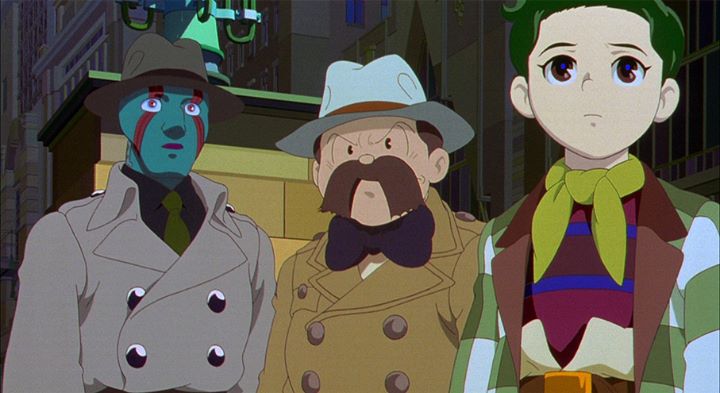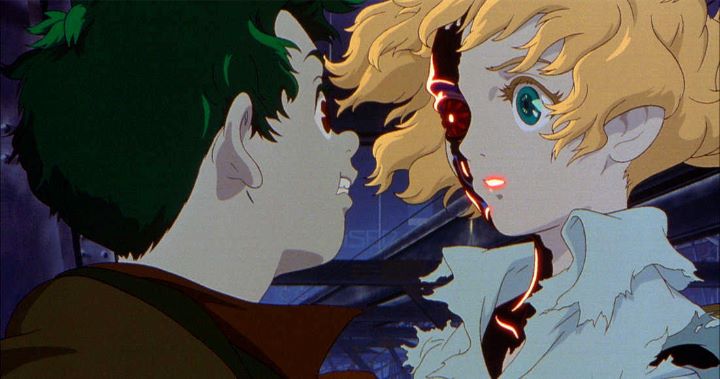








One of the greatest films of cinema has to be "Metropolis." No, I'm not talking about the classic German silent movie by Fritz Lang; I'm referring to the 2001 anime film. The movie is based on a manga by Osamu Tezuka, the same creator behind "Astro Boy," considered a hard-working equivalent to Walt Disney in terms of his impact on manga comics and animation in Japan. "Metropolis" is one among over 700 volumes of manga Tezuka created, and is in fact inspired by the German film, although Tezuka admitted he had only seen a still image of the movie when he started writing the comic. As such, any fans of the German film might be disappointed with how little similarities the two share in story. Similarly, the film based on the manga also barely follows the manga's story, changing some plot elements and names of important characters. The film script was written by none other than Katsushiro Otomo, the famous manga and film director behind the classic "Akira," and was directed by Rintaro, another respected figure in Japanese anime, working since the 1960's on properties like "Astro Boy," "Galaxy Express 999" and "Captain Harlock." That's a lot of big names in the pot, and one would think the movie would suffer from a lack of focus or incompatibility between creative minds. But I'm not kidding when I say "Metropolis" (the anime film) is a brilliant blockbuster adventure. Not perfect, mind, but impressive nonetheless.Set at an unspecified date many years into the future, the movie takes place in the grand city of Metropolis. Metropolis is a massive futuristic behemoth, and is divided into levels based on wealth and class: the rich and powerful live on the top (above ground), but poorer citizens live on Level 1 underground. The depths continue to Level 2 and 3, where sewage and power production is done, increasingly difficult for humans to live or work in. For this, humanoid specialist robots of all kinds are created to do menial tasks. Robots are a common part of everyday life in Metropolis, but they aren't treated with the respect that humans receive, with a special force dedicated to destroy robots that venture outside their designated level. Societal pressures intensify in Level 1, noting that robots have taken away their jobs and opportunities to leave the lower levels, even though there are many jobs that even unemployeed humans would never touch.And I haven't even gotten to the story yet! Japanese Detective Shunsaku and his nephew Kenichi visit Metropolis for the first time, on the hunt for Mad Scientist Dr. Laughton, suspected to be committing experiments against the law. Unbeknownst to them, Dr. Laughton is in fact working on a secret project at the request of Duke Red, a famous mogul with ties to the mayor. The project is to create a robot that perfectly resembles Duke Red's deceased daughter, Tima, with the intention to have her drive a massive tower that secretly acts as a weapon of mass destruction, called the Ziggurat. Duke Red's adopted son, Rock, acts as the leader of security, and insecure about seeing his father try to revive his lost child, Rock acts to destroy the project. So we have three main groups that revolve around Tima, with Kenichi at the center when he discovers her in the labratory fire, working to save her from patroling guards while teaching her language to recover her "memories." Also, a fourth group representing the resistence group from Level 1 trying to start a revolution, although their presence isn't of much consequence in the story.  It's an ambitious story in scale and scope. Somehow, it never feels too busy. Tima's delima, not being aware that she is a robot and eventually having to come to terms with it, isn't far off from "Pinocchio" or many other science-fiction stories involving A.I., but the story is rendered effectively. There are several powerful moments with well-written dialogue that makes for a memorable experience. It's definitely one of the better stories I've seen in a movie... if I avoid analyzing it too closely. When sitting down to think about the script, there are several moments when character actions don't make sense. Rock is subject to most of it: he's clearly a guy with daddy issues, and possibly a bit insane, but while it is usually clear what he is trying to do, it is never clear why he is doing it. This type of thing can be found all over the place in several characters. But even though the script isn't tight and devoid of plot holes, the tapestry it creates is still pretty amazing, right up to the tragic climax.Visually, "Metropolis" is a technical marvel, produced at a time when 3D digital animation was beginning to appear, but not long enough for it to become commonplace to replace crowds of people with 3D model templates. So we get magnificant skyscrappers with moving parts, with crowds of seemingly hundreds of hand-drawn people. The scale of the city is fantastic, and the detail (especially around Level 1) gives a lot of character to the world. Animation is smooth with a lot of character movement throughout. I am convinced that this might be one of the most expensive anime films ever made (at a budget of $15 million, it reportedly trails after "Steamboy" at $20 million, so not far off).Regarding the character designs... Osamu Tezuka was inspired by older Walt Disney cartoons in most of this work, using round faces and round, expressive eyes. It's a recognizable style, but not a great one: most of the characters have huge hands and feet, making even adults appear to be ten-years old. Looking more closely, the commitment to have film characters look like old cartoons is impressive, complete to villians with moustaches, large eyebrows and grins (2017 video game "Cuphead" is the only other media I can think of that recreates the style as effectively). At times, it even looks a lot like French comics like "Tintin." Paired with the old but still good-looking 3D animation, the movie doesn't look like typical anime. It has a much more timeless and interntaional quality to it.The music has an eccelctic mix, with symphonic scores when showcasing the majesty of the higher level, a more fun and jazzy score on the poorer Level 1, and using old early-1900's music recordings for the lowest levels (including a memorable use of "I Can't Stop Loving You" during the finale). The variety is respectable, and it works for the content. The English dub, made at a time when English dubs weren't particularly good, isn't all that great, although I have fond memories of the clever dialogue trying to match lip flaps (although the original Japanese dub is probably better here). Yes, "Metropolis" is a precious thing. There aren't many other anime films that can be called a "timeless classic" in such a true manner.
It's an ambitious story in scale and scope. Somehow, it never feels too busy. Tima's delima, not being aware that she is a robot and eventually having to come to terms with it, isn't far off from "Pinocchio" or many other science-fiction stories involving A.I., but the story is rendered effectively. There are several powerful moments with well-written dialogue that makes for a memorable experience. It's definitely one of the better stories I've seen in a movie... if I avoid analyzing it too closely. When sitting down to think about the script, there are several moments when character actions don't make sense. Rock is subject to most of it: he's clearly a guy with daddy issues, and possibly a bit insane, but while it is usually clear what he is trying to do, it is never clear why he is doing it. This type of thing can be found all over the place in several characters. But even though the script isn't tight and devoid of plot holes, the tapestry it creates is still pretty amazing, right up to the tragic climax.Visually, "Metropolis" is a technical marvel, produced at a time when 3D digital animation was beginning to appear, but not long enough for it to become commonplace to replace crowds of people with 3D model templates. So we get magnificant skyscrappers with moving parts, with crowds of seemingly hundreds of hand-drawn people. The scale of the city is fantastic, and the detail (especially around Level 1) gives a lot of character to the world. Animation is smooth with a lot of character movement throughout. I am convinced that this might be one of the most expensive anime films ever made (at a budget of $15 million, it reportedly trails after "Steamboy" at $20 million, so not far off).Regarding the character designs... Osamu Tezuka was inspired by older Walt Disney cartoons in most of this work, using round faces and round, expressive eyes. It's a recognizable style, but not a great one: most of the characters have huge hands and feet, making even adults appear to be ten-years old. Looking more closely, the commitment to have film characters look like old cartoons is impressive, complete to villians with moustaches, large eyebrows and grins (2017 video game "Cuphead" is the only other media I can think of that recreates the style as effectively). At times, it even looks a lot like French comics like "Tintin." Paired with the old but still good-looking 3D animation, the movie doesn't look like typical anime. It has a much more timeless and interntaional quality to it.The music has an eccelctic mix, with symphonic scores when showcasing the majesty of the higher level, a more fun and jazzy score on the poorer Level 1, and using old early-1900's music recordings for the lowest levels (including a memorable use of "I Can't Stop Loving You" during the finale). The variety is respectable, and it works for the content. The English dub, made at a time when English dubs weren't particularly good, isn't all that great, although I have fond memories of the clever dialogue trying to match lip flaps (although the original Japanese dub is probably better here). Yes, "Metropolis" is a precious thing. There aren't many other anime films that can be called a "timeless classic" in such a true manner.